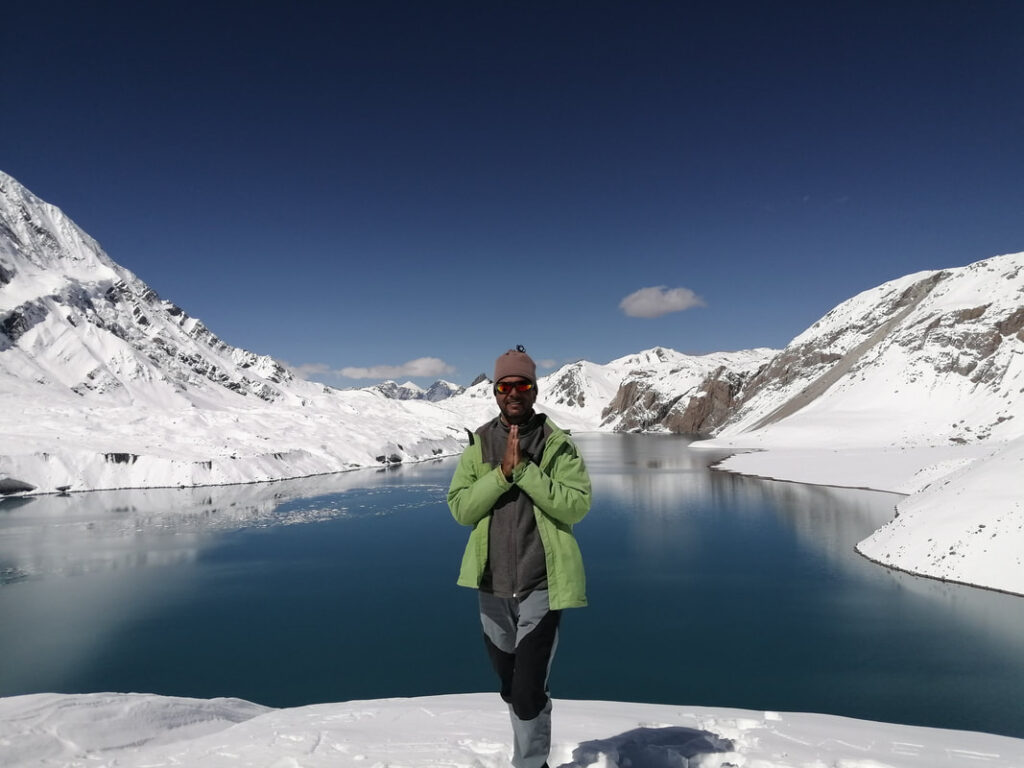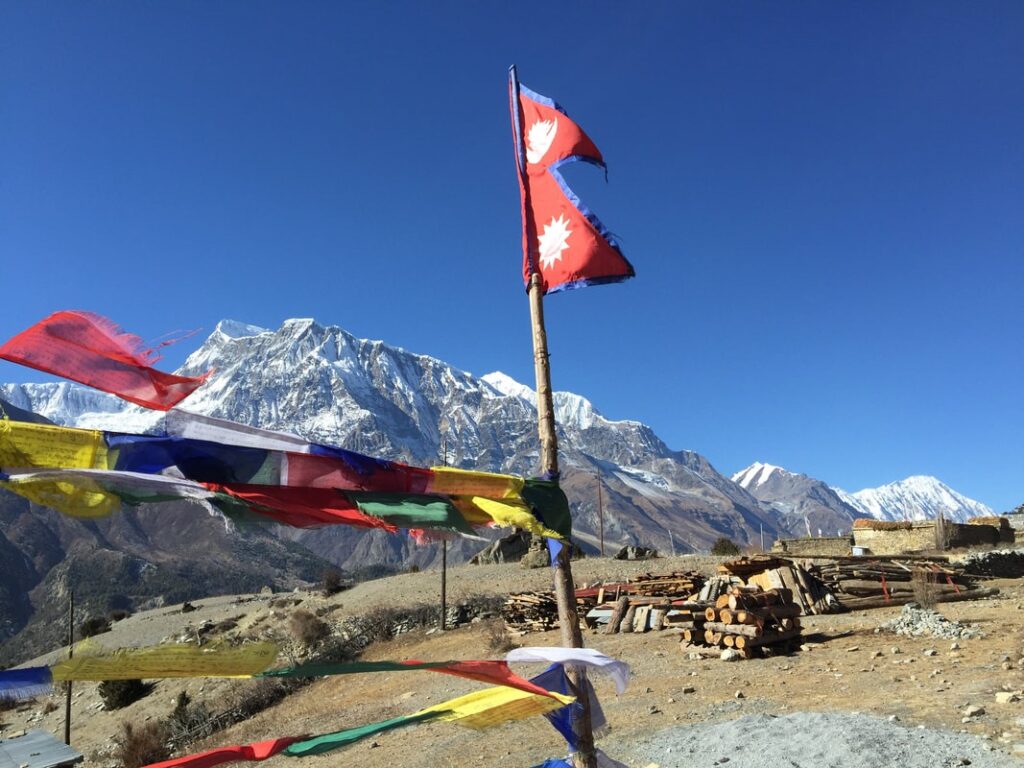Table of Contents
Complete Guide to Tilicho Lake Trek
Nestled in the heart of Nepal’s Annapurna region, the Tilicho Lake Trek is a bucket-list adventure for trekkers seeking a blend of natural splendor, cultural immersion, and high-altitude challenges. Often hailed as one of the world’s highest lakes at 4,919 meters, Tilicho Lake is a glacial marvel surrounded by towering Himalayan peaks like Annapurna and Tilicho Peak. This guide covers everything you need to know to plan your trek to this turquoise gem, including the best time to go, itinerary, difficulty, permits, how Big Sky Treks can enhance your experience, and tips for a safe journey. And here is the complete Guide to tilicho lake trek which include what to do what is included and what is not includes
Why Trek to Tilicho Lake?

The Tilicho Lake Trek is a side trip from the renowned Annapurna Circuit, offering a unique opportunity to explore a remote, high-altitude lake revered by Hindu pilgrims as a sacred site mentioned in the Ramayana. Trekkers are treated to breathtaking Himalayan views, diverse landscapes ranging from lush forests to alpine meadows, and cultural encounters with Gurung and Manangba communities. The trek also includes the option to cross the formidable Thorong La Pass (5,416m) or the adventurous Mesokanta La Pass (5,099m), making it a thrilling choice for adventure seekers.
Best Time to Trek

The optimal seasons for the Tilicho Lake Trek are spring (March–May) and autumn (September–November). During these months, the weather is stable, with clear skies offering stunning Himalayan views and moderate temperatures. Winter treks are possible but challenging due to icy conditions, while the monsoon season (June–August) brings rain and slippery trails, increasing risks in high-altitude areas like Tilicho Base Camp and Thorong La Pass.
Trek Difficulty and Preparation

The Tilicho Lake Trek is rated as moderate to strenuous, requiring good physical fitness and some trekking experience. The high altitude (up to 4,919m at the lake and 5,416m at Thorong La Pass) poses risks of altitude sickness, making acclimatization critical. Key challenges include:
- Steep ascents and descents: The trail from Khangsar Village to Tilicho Base Camp involves steep climbs and landslide-prone areas.
- High-altitude conditions: Thin air above 4,000m demands slow pacing and proper acclimatization.
- Remote terrain: Limited facilities beyond Tilicho Base Camp require careful planning.
Trekkers should pack lightweight, layered clothing, sturdy hiking boots, a reliable backpack, and safety gear like sunglasses and a raincoat. Garlic and warm water are recommended as natural remedies for altitude sickness.
Suggested Itinerary (10–14 Days)
The Tilicho Lake Trek can be completed in 10–14 days, depending on your pace and whether you combine it with the Annapurna Circuit. Below is a sample itinerary starting from Kathmandu:
Day 1: Drive from Kathmandu to Chame (2,710m)
- Duration: 8–10 hours
- Travel by bus or jeep to Besisahar, then to Chame, the gateway to the trek. Enjoy views of terraced fields and gorges.
Day 2: Trek from Chame to Pisang (3,230m)
- Duration: 5–6 hours
- Follow the Marsyangdi River through pine forests and Tibetan-style villages. Stay overnight in a teahouse in Pisang.
Day 3: Trek from Pisang to Manang (3,540m)
- Duration: 5–6 hours
- Traverse scenic trails with views of Annapurna II, Annapurna III, and Gangapurna. Overnight in Manang Valley.
Day 4: Acclimatization Day in Manang
- Spend a day acclimatizing to prevent altitude sickness. Take short hikes to Gangapurna Lake or Ice Lake, visit monasteries, or explore Manang Valley’s cultural sites, including the Braka Monastery.
Day 5: Trek from Manang to Khangsar Village (3,750m)
- Duration: 4–5 hours
- Walk through sparse vegetation to Khangsar Village, a traditional settlement with stunning mountain views.
Day 6: Trek from Khangsar to Tilicho Base Camp (4,150m)
- Duration: 5–6 hours
- Navigate narrow trails and landslide-prone sections to reach Tilicho Base Camp. Stay in a basic teahouse and prepare for the lake visit.
Day 7: Trek to Tilicho Lake (4,919m) and Return to Shree Kharka
- Duration: 10–12 hours
- Start early (around 4 a.m.) for a challenging ascent to Tilicho Lake. Marvel at its turquoise waters and surrounding peaks like Tilicho Peak and Annapurna. Return to Shree Kharka for the night.
Day 8: Trek from Shree Kharka to Yak Kharka (4,050m)
- Duration: 4–5 hours
- Descend through rocky paths, passing Khangsar Village, to join the Annapurna Circuit trail at Yak Kharka.
Day 9: Trek from Yak Kharka to Thorong High Camp (4,925m)
- Duration: 4–5 hours
- Ascend gradually to prepare for crossing Thorong La Pass. Overnight at a teahouse in Thorong High Camp.
Day 10: Trek from Thorong High Camp to Muktinath via Thorong La Pass (5,416m)
- Duration: 8–9 hours
- Cross the iconic Thorong La Pass, enjoying panoramic Himalayan views and prayer flags. Descend to Muktinath Temple, a sacred site for Hindus and Buddhists.
Day 11: Drive from Muktinath to Jomsom (2,700m)
- Duration: 3–4 hours
- Take a jeep to Jomsom, a bustling town in the Mustang region, and explore local markets.
Day 12: Flight or Drive from Jomsom to Pokhara
- Duration: 25-minute flight or 8-hour drive
- Opt for a scenic flight to Pokhara or a drive if flights are canceled. Relax by Phewa Lake in Pokhara.
Day 13–14: Return to Kathmandu
- Drive or fly back to Kathmandu (6–7 hours by bus or 25-minute flight). Spend the final day sightseeing in Kathmandu, visiting sites like Boudhanath Stupa.
Note: For a shorter trek, you can return to Chame after visiting Tilicho Lake instead of crossing Thorong La Pass. Alternatively, adventurous trekkers can opt for the Mesokanta La Pass route, extending the journey by 1–2 days.
How Big Sky Treks Will Help You

Partnering with a reputable trekking agency like Big Sky Treks can transform your Tilicho Lake Trek into a seamless and enriching experience. Big Sky Treks, a trusted name in Nepal’s trekking industry, specializes in organizing high-altitude adventures with a focus on safety, cultural immersion, and personalized service. Here’s how they can enhance your journey:
- Expert Guides and Porters: Big Sky Treks provides experienced, English-speaking guides who are well-versed in the Annapurna region’s terrain, culture, and safety protocols. Their guides ensure safe navigation through challenging sections like the landslide-prone trail to Tilicho Base Camp and offer insights into local Gurung and Manangba traditions. Porters handle heavy loads, allowing you to focus on enjoying the trek.
- Tailored Itineraries: Whether you’re a solo trekker or part of a group, Big Sky Treks customizes itineraries to suit your pace and preferences, including options to combine the trek with Thorong La Pass or Mesokanta La Pass.
- Logistical Support: From securing Annapurna Conservation Area Permits (ACAP) and TIMS cards to arranging transportation from Kathmandu to Chame and Jomsom to Pokhara, Big Sky Treks handles all logistics, saving you time and effort.
- Safety and Acclimatization: Their team emphasizes proper acclimatization with strategic rest days in Manang Valley and provides advice on managing altitude sickness, ensuring a safer ascent to Tilicho Lake (4,919m).
- Cultural Experiences: Big Sky Treks arranges visits to cultural sites like Muktinath Temple and local monasteries, enhancing your connection to the region’s Hindu pilgrimage heritage.
- Eco-Conscious Travel: Committed to sustainable tourism, Big Sky Treks promotes responsible trekking practices to preserve the pristine beauty of the Annapurna range and glacial lake.
With Big Sky Treks, you’ll have peace of mind knowing that every detail—from teahouse bookings to emergency support—is expertly managed, letting you immerse fully in the awe-inspiring Himalayan views.
Permits and Costs
To trek in the Annapurna region, you’ll need:
- Annapurna Conservation Area Permit (ACAP): Approx. $30
- Trekkers’ Information Management System (TIMS) card: Approx. $20
Trek costs vary based on duration, transportation, and services (guide/porter). A typical 10-day package with an agency like Big Sky Treks ranges from $650–$1,700, covering permits, teahouse accommodation, meals, and guides. Private treks or luxury options may cost more.
Cultural and Spiritual Significance
Tilicho Lake holds deep spiritual importance for Hindus, believed to be the Kak Bhusundi Lake from the Ramayana, where sage Kak Bhusundi narrated the epic to Garuda. Hindu pilgrims visit during August’s full moon for sacred baths. The trek also passes the Muktinath Temple, a revered site for both Hindus and Buddhists, adding a profound cultural dimension.
Tips for a Successful Trek
- Acclimatize properly: Spend a day in Manang Valley to adjust to the altitude. Hike to higher elevations and return to sleep lower to reduce altitude sickness risks.
- Pack light: Leave heavy bags at Tilicho Base Camp for the day hike to the lake. Carry essentials like warm water and snacks.
- Hire a guide/porter: Agencies like Big Sky Treks provide experienced guides for safety and cultural insights, especially in remote areas like Khangsar Village.
- Start early for the lake: Begin the hike to Tilicho Lake at 4 a.m. to avoid afternoon winds and ensure safe crossing of landslide-prone areas.
- Respect local culture: Dress modestly and seek permission before photographing locals or religious sites like Muktinath Temple.
Highlights of the Trek

- Tilicho Lake: A turquoise glacial lake at 4,919m, surrounded by Annapurna range peaks.
- Thorong La Pass: The world’s longest high-altitude pass at 5,416m, offering unparalleled Himalayan views.
- Manang Valley: A cultural hub with monasteries, apple farms, and views of Gangapurna and Pisang Peak.
- Khangsar Village: A traditional settlement with rustic charm and mountain vistas.
- Biodiversity: Spot Himalayan thars, blue sheep, and griffon vultures amidst rhododendron forests and alpine meadows.
Conclusion
The Tilicho Lake Trek is a journey of contrasts—challenging yet rewarding, remote yet spiritually vibrant. Whether you’re drawn to the serene beauty of the glacial lake, the thrill of crossing Thorong La Pass, or the cultural richness of Manang Valley, this trek promises an unforgettable adventure. Partnering with Big Sky Treks ensures a well-organized, safe, and immersive experience, allowing you to focus on the magic of the Annapurna region. Book with a reputable agency for a seamless journey, and prepare to leave your footprints at one of the world’s highest lakes.
